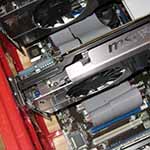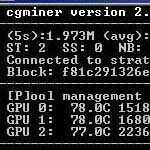Guide: Build your own Litecoin Mining Rig
Want to get into mining digital currency (bitcoins, litecoins, and/or other altcoins), but have no idea how to go about it? This guide will take a complete beginner through the various steps involved in building your own power-efficient ~1900 kH/sec litecoin mining computer.
Guide: Build your own Litecoin Mining Rig
4/06/2017: This guide is nearly four years old. While the Windows and Linux setup portions are still somewhat useful in a general sense, please don’t attempt to buy any of the hardware recommended in part 1—it’s quite obsolete! If you’re looking for information about modern GPU mining, please click here for my updated 2017 guide on Ethereum mining.
Click the image or heading in each section to jump to that piece of the guide.
 |
Part 1: HardwareLearn what components give you the best bang-for-the-buck when it comes to litecoin mining. See what you’ll need to pack multiple GPUs into a single computer for maximum efficiency. Then, follow a step-by-step guide on how to assemble everything into a plastic milk crate to facilitate airflow and cooling. |
 |
Part 2: Linux SetupFollow a detailed set of instructions that will have you up and running with Linux on your litecoin mining rig in about an hour. The guide is tailored to the complete Linux beginner and includes every single command that you’ll need to input—no guesswork or incomplete steps! |
 |
Part 3: Windows SetupIf Windows is more to your liking, we’ve got a guide for you, too. Covers a complete installation from start to finish: BIOS settings, drivers, mining software, auto-startup, remote admin, and more. For more advanced users, undervolting your GPUs (to save power) is also included as an optional step in the guide. |
 |
Part 4: OptimizationAfter you’ve got your litecoin mining rig running, check out the optimization guide for tips on getting the best performance possible from your GPUs via overclocking and cgminer tweaks. Also learn how to set up an automatic failover mining pool, so that your rig will continue mining even if your primary pool becomes unavailable. |
 |
Part 5: Mining FAQRead the rest of the guide, but still have some questions? Chances are it’s covered in this FAQ. |





